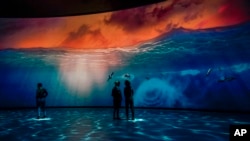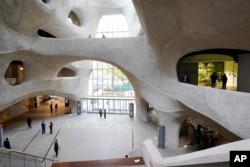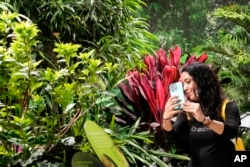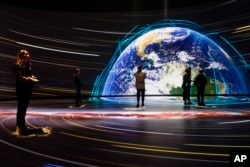This week, the American Museum of Natural History in New York is going to open its new building.
The structure is designed to connect visitors with their place in the natural world.
Small ants walk along a glass bridge in the new museum area, The Richard Gilder Center for Science, Education and Innovation. Whales move along the walls in an immersive video. And the building’s natural curves — inspired by canyons in the American Southwest — are meant to show how all of it is connected.
The $465 million center, nearly ten years in the making, is set to open to the public on May 4.
Architect Jeanne Gang spoke at a recent media event about her design. She said she asked herself how the space could add to peoples’ natural interest in learning. “This led us to look at geological landscapes, where one can see how the natural forces actually shape the material, shape our world,” she said.
The Gilder Center is already home to more than a half million small creatures, part of an insect exhibition with 18 species.
It includes an indoor garden where visitors can see hundreds of moths and butterflies.
The goal is to get people “up close and personal” with the bugs and highlight their importance to the natural world, said museum entomologist David Grimaldi.
He added that insects have a bad reputation because of the very small percent of them that bite or spread diseases. But most insect species present no danger to humans and are a necessary part of the environment, Grimaldi explained.
Brightly colored butterflies fly around the garden, while large beetles eat old fruit.
And then there are the ants. The museum shipped in around 500,000 leafcutter ants to build a colony in the insectarium – or insect area. The small ant workers collect their leaves from one glass area, then walk across a skybridge to grow their fungal food in glass areas along the wall.
The ants needed some help getting used to the space. Scientists had to hold “training” exercises to show them where to go, said Cheryl Hayashi, the museum’s science chief.
A new interactive show presents the ways our lives are mixed with the lives of other beings. “Invisible Worlds” puts visitors in different settings. These scenes show the proteins in human DNA and neural connections in the brain. Then viewers see the New York City skyline or the top of a rainforest.
“Through DNA, you are related to all life on Earth,” a speaker declares.
The Gilder Center is also designed to bring the scientific process to the front, said museum president Sean Decatur.
More than 4 million specimens from the museum’s collections are now being housed in the Gilder Center. Some are on show behind big glass windows.
This “Collections Core” shows off a number of objects, from megalodon teeth to Mayan bricks to spools of spider silk.
Building trust in the scientific process is more important than ever, said Ellen Futter, the museum’s former president who oversaw most of the Gilder Center’s creation before retiring in March.
“That is the vision: To help visitors see and understand our world more deeply,” Futter said. “To appreciate that all life is” connected. “To trust science and to be inspired to protect our precious planet.”
I’m John Russell.
Maddie Burakoff reported on this story for the Associated Press. John Russell adapted it for VOA Learning English.
__________________________________________________________________
Words in This Story
museum – n. a building in which things are collected and shown to the public
immersive – adj. providing or characterized by deep absorption or immersion in something
inspire – v. to give (someone) an idea about what to do or create
architect – n. a person who designs buildings
entomologist – n. a scientist who deals with the study of insects
specimen – n. an animal or plant collected as an example of a particular kind of thing













Forum